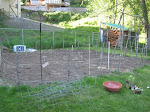The Nabataeans channeled water from springs nearly 5 miles away, flood waters and aqueducts to transform their capital city into a desert oasis that housed nearly 30,000 people in the main 2 mile square downtown.
Making our way to the main city center and lunch
But how did a tribe of nomadic herdsman come to be known as the richest empire during the time of Christ? Frankincense and myrrh. One legend says that the wise men stopped at Petra to buy gifts for Baby Jesus on their way to Bethlehem. They controlled the trade routes through the desert and collected high tolls along the way. Enough tolls to create a Biblical-era Las Vegas.
Although less than 2% of Petra has been excavated, it has been discovered that there was a large pool (80 feet by 140 feet) with an island pavilion in the middle next to a large garden terrace in what was previously believed to be the marketplace.
The colonnaded street was lined by a canal and squares contained fountains flowing with water.
We met up with the whole group for lunch, ate as quickly as possible and headed back out to explore...
In 106, Petra was annexed into the Roman Empire. Later it became a thriving Christian community with several churches. Christians were martyred here for refusing to worship Roman gods. Bishops from Petra were sent to councils and synods of the early Church. Three Byzantine era churches still remain: the Petra Church, the Blue Chapel and the Ridge Church. Some beautifully preserved mosaics still remain in the Petra Church. And you can still see some of the blue Egyptian granite columns from the Blue Chapel.
By this time we were very hot and we had to hustle back to the entrance to get back on the bus. But we still took some time to take a few more pictures and buy some souvenirs from some of the stalls along the way.
*Funny story: One of the guys we bought from claimed he made all of the items in his stall by hand. It was uncanny how they were exactly like all the other magnets and wall hangings we'd seen in stores all over Jordan. LOL












































No comments:
Post a Comment